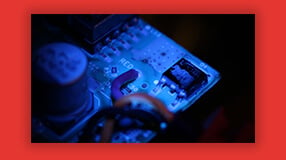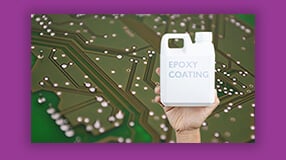Conformal Coating vs Potting/Encapsulation - The Pros & Cons

You have a few options for coating a PCBA: conformal coatings or potting and encapsulation resins. These organic polymers provide chemical and thermal resistance and electrical insulation to the delicate PCBA beneath them. But that’s where most of their similarities end. This guide will discuss the differences between encapsulation resin and conformal coating and their effects on a PCBA.
What’s the Difference Between Conformal Coatings and Potting?
While both potting/encapsulation and conformal coatings protect a PCBA, they do so differently.
Electronic encapsulation seals a PCBA within a thick resin layer to protect substantially against physical shock, chemical exposure, and excellent electrical properties. Usually, this resin is dark-colored, so you won’t be able to see the board underneath it. The resin is mixed with a hardener before application, which allows it to cure a cross-linked polymer.
So, what is potting? While “encapsulation” and “potting” are used interchangeably, potting sometimes refers to the process used for PCBA encapsulation.
Alternatively, a conformal coating is a protective dielectric layer that is non-conductive. It protects from dangers like salt spray, fungus, moisture, and corrosion. The film, composed of epoxy conformal coating, acrylic, or silicone, is very thin and lightweight, having almost no dimensional effect on the PCBA or added stress to the components. Processing and applying this single-component material is easy and versatile, providing flexible options for the finished product.
While traditional coatings are single-component, some newer ones use a two-part process with polyurethane conformal coating to blend the protective aspects of PCBA potting with the flexibility of coatings. Plus, they don’t use solvents, which reduces concerns about volatile organic compounds (VOCs) present in many low-viscosity single-component coatings and adversely affects people and the environment. Fortunately, even those have come a long way, as most manufacturers have worked to reduce VOCs in their coatings.
Which Is Better to Protect My PCBA — Conformal Coating or Potting?
To best protect your PCBA, you’ll have to consider several factors of your product and how PCB resin coating and potting contribute to them.
Environmental factors play a significant role in choosing a protective material. Will your PCBA be exposed to any of the following?
- Extremely high or low temperatures: You will have to consider the way resin can behave during use in extreme temperatures, how sudden or gradual the change is, and how heat could affect production. Resin generates a lot of heat when mixed with its hardener, which can cause damage to the PCBA or the housing if it gets too hot.
- Water, humidity, or moisture: Some conformal coatings are less waterproof than others. While the resin is typically always waterproof, you’ll have to double-check that your coating is, too.
- Physical shock: If your component might be exposed to heavy physical shock, the resin can help spread the impact across the material and reduce or eliminate the damage to the PCBA.
- Mechanical stress: Abrasion and scratches can become problematic in environments like assembly lines and manufacturing equipment, where high speeds and volumes are typical. Resin provides a thick layer to protect against that physical threat.
- Chemical exposure: If your PCBA could be exposed to harsh chemicals, both resin and coatings provide exceptional protection from exposure and submersion.
While PCBA potting offers more protective benefits, coatings hold the upper hand in design flexibility and can still protect products in everyday environments, like consumer electronics. Only those that are in particularly challenging environments typically need PCBA encapsulation.

Below are some design factors that factor into the debate:
- Weight: Resin adds a thick block of material on top of the board, significantly increasing its weight. In many products, heavyweight components aren’t an option.
- Thickness: Many products can’t function with the added thickness of the resin added to their design.
- Workability: Since resin is dark and thick, you can’t see through it or easily remove it to rework the board. It could rip up the PCBA if you tried to take it off. Coating, on the other hand, is usually clear, which allows you to see through it and make adjustments if needed. This helps address any conformal coating defects.
- Housing: If the housing of the PCBA doesn’t offer much protection, the resin may be a way to protect it more thoroughly. Coatings are often used as secondary protection within well-built housing.
- Application: Depending on the design requirements, one option may be better for production. Resin can add risky heat during application and takes longer to cure. Conformal coatings tend to be quick-drying and can be applied in several ways, such as painting it with a brush, spraying it on, dipping the PCBA, and using robotic systems.
Conformal coatings are an excellent way to protect a PCBA from common threats without paying for the added weight and cost of encapsulation.
Here at HZO, we use a coating called Parylene, which is biocompatible — meaning it’s great for the medical devices industry — and extremely thin. It is clear and excellent for waterproofing and liquid protection.
Pros and Cons of Potting/Encapsulation
Designers often choose PCBA encapsulation for products in heavy-duty environments, as it protects against many damaging agents.
Some of the benefits of PCBA potting include the following:
- Provides added protection against chemical, thermal, and physical risks, including water and shock.
- Offers better performance for high-speed and high-volume work in industrial environments.
- Has VOC-free options.
Some disadvantages of PCBA potting are:
- It makes it difficult to inspect or rework the PCBA.
- Causes possible design issues due to the added weight and thickness.
- A more complex application process, especially regarding heat and two-part mixing.
Pros and Cons of Conformal Coating
Conformal coating is more popular than potting. It protects many consumer products outside dangerous exposure environments and provides more design flexibility. However, if your product is used in rough applications, it may not offer all the necessary protections.
Here are some of the pros of conformal coatings.
- Thin and lightweight, offering superior design flexibility and no stressed components.
- Offers protection from low-level issues like salt spray, dust, moisture, and corrosion.
- Offers a variety of application methods.
- Newer options with low VOCs.
- Long lifespan.
The negatives of conformal coatings include:
- Offers less robust protection against heavy-duty threats.
- Contains VOCs within the solvents, though these are becoming less abundant.
Contact Us Today to Protect Your PCBA
If you’re still unsure about which option is best for your PCBA, our expert team of HZO engineers can help. We realize that your needs are just as unique as our coatings, so we will work closely with you to provide custom coating solutions.
To learn more, contact us or call us today at 1-877-757-4496.
6 Common Conformal Coating Defects & Their Solutions
Conformal Coating Removal - How to Get Started W/Reference
Epoxy Conformal Coating Evaluation Guide
Mallory is a veteran writer with over a decade of writing experience and has spent over five years at HZO learning about coating technology from the best minds in the industry. Professionally, Mallory is especially interested in the process of problem-solving and watching how the engineering team develops solutions that ensure business requirements are met. Over her years at HZO, Mallory's writing has been cited in industry whitepapers, including "Parabolic Model for Optimum Dry Film Thickness (DFT) of Corrosion Protective Coatings" and "Universal Approach to Integrating Reduced Graphene Oxide into Polymer Electronics." All of Mallory’s blogs are reviewed for accuracy before publication.
Additional Resources

Which is Better For Your Application? Conformal Coating or Potting?

Learn About Common Conformal Coating Defects And How To Fix Them

Learn How To Incorporate Conformal Coating Into Your Manufacturing Process









